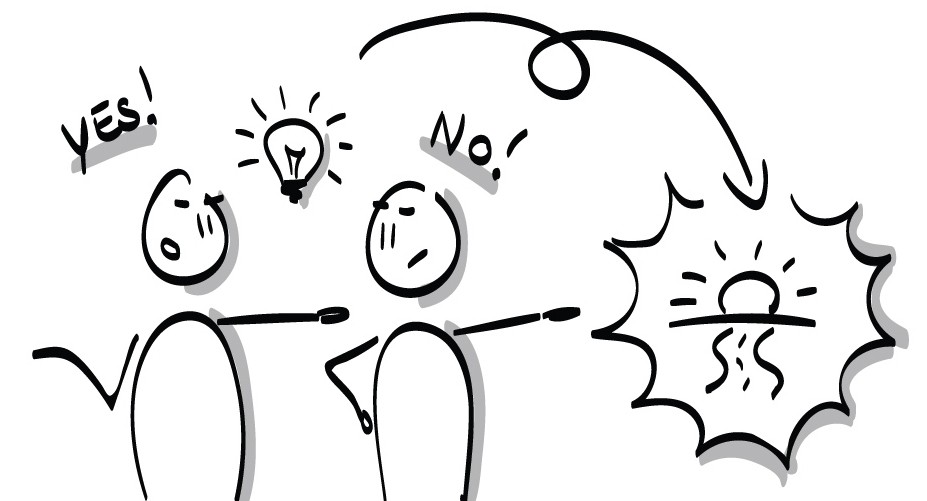Cooperative meetings
Meetings: almost everyone has to deal with them with some regularity. Some love it and find it useful, but more often we hear people complain about "too many" and "useless" meetings. What is your meeting culture like? A waste of time or a valuable part of the business process?
In this blog, some principles, four key steps and a check for a cooperative meeting!
Principles
For a meeting to be cooperative and useful, it is important that people actively participate. This requires a good preparation, commitment of all present and good leadership. On the Scale of Cooperation, in a cooperative situation we expect active behaviour of people, in a equivalent setting. Participants are not equal, but they are equal where their input is concerned. The director's view is important, as is the youngest employee's comment about his or her doubts about something. It is about interaction with each other.
The larger the group, the easier it becomes to avoid active participation. In addition, in practice, we see all too often that too many meetings are scheduled, so people don't have/take the time to prepare them properly, so you still can't reach concrete decisions in the meeting and so another meeting has to be scheduled. And as long as those attending and leading the meetings allow this to happen, this circle can continue to repeat itself.
On the Scale, in the world of cooperation we see the positions of 'creating clarity', 'feedback' and 'securing'. In a cooperative setting, it is clearlywhy we meet, with whom, when and what is expected of each person.
Step 1: Who are we meeting with and what is expected of those attending?
Should every meeting take place with the whole team? Should everyone be present at every agenda item? Dare to make choices! Avoiding these choices and always sitting in a meeting with the whole team (insufficiently prepared) gives little energy and rarely leads to supported decisions. What preparation is expected? And what if someone comes to the meeting unprepared? Coming to a meeting unprepared but still wanting to join the discussion on the topic regularly leads to frustration among those who did prepare and often causes unnecessarily long discussions on content that should have been read beforehand.
Step 2: the meeting objective is clear
Then, for each meeting point, what is needed: forming an opinion, forming a judgment or making a decision? In the case of decision-making, it must be clear how and on what a decision will be taken. In the case of opinion-forming, it must be clear what an opinion is sought and what will be done with it. Do the opinions have real weight or is input mainly needed for a decision that will be taken elsewhere?
In the case of image and judgment, there is a shared responsibility for both the participants and the leadership of the meeting to ensure that everyone can be heard. Sometimes it helps here to make a conscious choice in the order of speaking, for example the most senior people speak last, to increase the chances of everyone giving his/her sincere opinion.
Feedback in a meeting can also be a 'purposeful discussion' or 'constructive conflict'. In this, there is an eye for team interest and task interest. And everyone feels they can speak freely and express their opinions honestly. And can rely on listening to each other out of curious interest. Such a discussion can take place during the meeting, but for some people it works better to discuss their opinions in private beforehand or afterwards. For some, this is a roundabout way, for others it means 'also' being heard.
Step 3: everyone has been sufficiently heard
Making a decision requires a check towards the goal and whether everyone has been heard. Has the group been able to form an opinion? Only when everyone feels well heard and ready for judgement do you move on to the process of decision-making. Successful teams weigh minority judgement heavily. Is an adjustment possible so that everyone can go along committedly? Especially the dissenting opinions are important because they make the final outcome better! This mix of 'your opinion counts' and 'how can we take this dissent into account' ensures that difficulties are actively transformed into opportunities.
This process, too, can be easily evaded if difficulties are seen but not brought to the table. The result: a great decision, but no full commitment from the whole team. And then it remains to be seen whether the decision will be implemented....
Step 4: decisions are secured
Securing is then the final challenge. It means shaping the actions that follow the decision supported by all. If we have decided 'X', what does that mean for person A, department B, the customer, and so on? Who is responsible for what and when do we come back to it? What results do we expect when? Who thinks they need help with something? And when do we evaluate and possibly adjust the decision? If a decision is taken and shaped in this way, it will gain support and people will certainly do their best to make it happen.
The final check: you leave the meeting with energy!
A good and supported decision gives energy: you have been sufficiently heard, difficulties have been named and a direction has been chosen. The dot on the horizon is clear and challenging. When pressure is put on the team and everyone knows what to do, flow is created, a sense of wanting to deliver what has been agreed.

